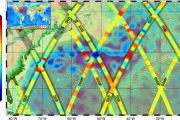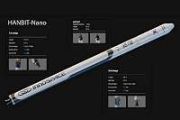
Copernical Team
SPACECENT Hosts Second Annual CENTCOM Theater Space Forum with Global Experts
 In a strategic move to bolster space capabilities within the U.S. Central Command (CENTCOM) operations, the U.S. Space Forces Central (SPACECENT) recently convened the second annual CENTCOM Theater Space Forum. This significant gathering, held at an undisclosed location in Southwest Asia, saw the participation of over 140 space experts from the five branches of the U.S. Defense Department, multi
In a strategic move to bolster space capabilities within the U.S. Central Command (CENTCOM) operations, the U.S. Space Forces Central (SPACECENT) recently convened the second annual CENTCOM Theater Space Forum. This significant gathering, held at an undisclosed location in Southwest Asia, saw the participation of over 140 space experts from the five branches of the U.S. Defense Department, multi Luxembourg DoD Partners with SES and HITEC to Augment SATCOM Ground Infrastructure
 The Luxembourg Directorate of Defence (DoD) procured two ground stations following a competitive call for tender to enable the Luxembourg Army to improve its resilience by accessing secure satellite communications services, the DoD, SES and HITEC Luxembourg said today.
The ground stations, which will be installed at the Luxembourg Army's Military Centre in Diekirch, will be used for Luxemb
The Luxembourg Directorate of Defence (DoD) procured two ground stations following a competitive call for tender to enable the Luxembourg Army to improve its resilience by accessing secure satellite communications services, the DoD, SES and HITEC Luxembourg said today.
The ground stations, which will be installed at the Luxembourg Army's Military Centre in Diekirch, will be used for Luxemb Virgin Voyages Sets Sail with the Fastest Internet at Sea
 In a groundbreaking move for maritime connectivity, Virgin Voyages has announced its partnership with satellite communications giants SES and Starlink to offer the fastest internet service at sea. This collaboration will see the deployment of the SES Cruise mPOWERED + Starlink PRO service across Virgin Voyages' fleet, marking the first time a cruise line integrates Medium Earth Orbit (MEO) and L
In a groundbreaking move for maritime connectivity, Virgin Voyages has announced its partnership with satellite communications giants SES and Starlink to offer the fastest internet service at sea. This collaboration will see the deployment of the SES Cruise mPOWERED + Starlink PRO service across Virgin Voyages' fleet, marking the first time a cruise line integrates Medium Earth Orbit (MEO) and L Turkcell Partners with Lynk for Satellite-Direct Mobile Services in Turkiye
 Lynk Global, Inc. (Lynk), the world leader in satellite-direct-to-mobile-phone technology, has partnered with Turkcell (NYSE: TKC), Turkiye's premier mobile operator, to initiate Sat2Phone services across the country. This collaboration leverages Lynk's innovative "cell-towers-in-space" to bolster network resilience and extend mobile coverage, ensuring that the Turkish populace, businesses, and
Lynk Global, Inc. (Lynk), the world leader in satellite-direct-to-mobile-phone technology, has partnered with Turkcell (NYSE: TKC), Turkiye's premier mobile operator, to initiate Sat2Phone services across the country. This collaboration leverages Lynk's innovative "cell-towers-in-space" to bolster network resilience and extend mobile coverage, ensuring that the Turkish populace, businesses, and Rocket Lab's Spacecraft Line: Bridging Missions from LEO to Deep Space
 Rocket Lab USA, Inc. (NASDAQ: RKLB) has announced its expanded family of spacecraft buses, a culmination of over four years dedicated to advancing its space systems capabilities. This development signifies a strategic enhancement in Rocket Lab's offering to the space sector, aligning with the diverse needs of its clientele across various missions.
Peter Beck, Rocket Lab's founder and CEO,
Rocket Lab USA, Inc. (NASDAQ: RKLB) has announced its expanded family of spacecraft buses, a culmination of over four years dedicated to advancing its space systems capabilities. This development signifies a strategic enhancement in Rocket Lab's offering to the space sector, aligning with the diverse needs of its clientele across various missions.
Peter Beck, Rocket Lab's founder and CEO, Have We Found a Direct Descendant of the First Stars?
 The star J1010+2358 may have descended from just one of the first stars, which would make it a powerful probe of the elusive first generation of stars. However, new research finds that its properties are consistent with a range of stellar ancestries.
b>Seeking the First Generation of Stars br> /b>
The first stars in the universe collapsed into being in clouds of pristine gas containing j
The star J1010+2358 may have descended from just one of the first stars, which would make it a powerful probe of the elusive first generation of stars. However, new research finds that its properties are consistent with a range of stellar ancestries.
b>Seeking the First Generation of Stars br> /b>
The first stars in the universe collapsed into being in clouds of pristine gas containing j Axion stars: A potential key to solving the cosmic dark matter mystery
 In a significant advancement in astrophysics, a team of physicists from King's College London has introduced a groundbreaking approach to demystify dark matter, potentially bringing us closer to understanding one of the universe's most elusive constituents. The research, led by Liina Chung-Jukko alongside Professors Malcolm Fairbairn, Eugene Lim, Dr. David Marsh, and their collaborators, focuses
In a significant advancement in astrophysics, a team of physicists from King's College London has introduced a groundbreaking approach to demystify dark matter, potentially bringing us closer to understanding one of the universe's most elusive constituents. The research, led by Liina Chung-Jukko alongside Professors Malcolm Fairbairn, Eugene Lim, Dr. David Marsh, and their collaborators, focuses Earth as a test object
 Life is indeed possible on Earth. This has been demonstrated in a study conducted by the Institute of Particle Physics and Astrophysics at ETH Zurich. Of course, the researchers' intention wasn't to answer the question itself. Instead, they used the Earth as an example to prove that the planned LIFE (Large Interferometer for Exoplanets) space mission can be a success - and that the planned measu
Life is indeed possible on Earth. This has been demonstrated in a study conducted by the Institute of Particle Physics and Astrophysics at ETH Zurich. Of course, the researchers' intention wasn't to answer the question itself. Instead, they used the Earth as an example to prove that the planned LIFE (Large Interferometer for Exoplanets) space mission can be a success - and that the planned measu CUTE's groundbreaking design paves the way for future small-scale space missions
 NASA's innovative approach to studying the atmospheres of distant worlds has taken a significant leap forward with the Colorado Ultraviolet Transit Experiment (CUTE) mission. Since its launch in September 2021, CUTE has been pioneering the observation of exoplanets using a uniquely designed small spacecraft, marking a milestone in space exploration technology.
At the heart of CUTE's missio
NASA's innovative approach to studying the atmospheres of distant worlds has taken a significant leap forward with the Colorado Ultraviolet Transit Experiment (CUTE) mission. Since its launch in September 2021, CUTE has been pioneering the observation of exoplanets using a uniquely designed small spacecraft, marking a milestone in space exploration technology.
At the heart of CUTE's missio US Moon lander's battery likely has hours left: company
 An American lunar lander that tipped over during its historic touchdown last week likely only has hours left until its battery runs out, the private company operating it said Tuesday.
The uncrewed Odysseus, built by Houston-based Intuitive Machines, made the first return by a US craft to the Moon in five decades - and the first such successful mission by the private sector.
But one of t
An American lunar lander that tipped over during its historic touchdown last week likely only has hours left until its battery runs out, the private company operating it said Tuesday.
The uncrewed Odysseus, built by Houston-based Intuitive Machines, made the first return by a US craft to the Moon in five decades - and the first such successful mission by the private sector.
But one of t 



























